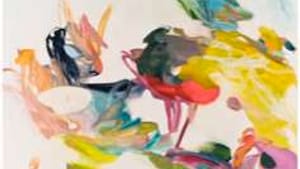Stay in the Loop
BSR publishes on a weekly schedule, with an email newsletter every Wednesday and Thursday morning. There’s no paywall, and subscribing is always free.
If it's abstract, why not call it Untitled?
Jan Baltzell at Schmidt-Dean Gallery

The painter Bill Scott once said at a talk at the Sketch Club in Philadelphia that he switched from painting still lifes to abstractions so that he could avoid discussion of his paintings at the family Thanksgiving table. At a Woodmere lecture some years back, painter Diana Kingman also confessed that she named her abstract paintings by randomly assigning titles she had preconceived and kept on file (thus Kingman's Mountain Wreath is not really a mountain wreath).
My own father, who painted abstractly when I was a child, would teasingly play "Name this painting" with me. My five-year-old mind, seeking some structure in his abstraction, would assign such "imaginatively" descriptive titles as Bird in Flight or Forest Trees. Nevertheless, he usually adopted the ever-popular Untitled as title for his paintings.
Abstract and non-objective painters can be especially stubborn about naming their paintings descriptively, even when the viewing public may crave some sort of pre-set orientation— some concrete place to start thinking about it. Perhaps that's because, as I've come to understand many years later, this sort of painting isn't about capturing some image that exists in reality. It's about conducting a process that will lead to creation of images that suggest rather than depict.
Intuitive process
No surprise, then, that the painter and Pennsylvania Academy professor Jan Baltzell eschews descriptive titles in her exhibition of luminous abstractions at the Schmidt-Dean Gallery. (She does graciously undertake the challenge of explaining her work to her audience via this
tape produced by the gallery.)
Because abstract painting comes as an intuitive process to the artist, ideally the viewer doesn't seek those titles and descriptions. Instead you allow yourself to be carried off by what you see.
So get lost in the looped and tangled lovely lines, the smooth textures, and juicy colors of Baltzell's work and you will quite likely be rewarded in an unusual way. You may find yourself feeling harmonized and balanced.
There is a Japanese sort of elegance to these works, with curving lines, meandering from an apricot tendril here to a washed pool of periwinkle there and then on to a bridge of mossy green. Whiteness of unmarked surface serves as significant counterpoint to colored space.
Like De Kooning, calmed down
Somehow, these paintings remind me of the work of two diametrically different artists: They convey the rhythm and lightness of mark-making by the 17th-Century Japanese artist Hon' ami Koetsu, but also the brushy exuberance of Willem de Kooning, but calmed a bit— as if Willem has had a cup of chamomile tea.
Baltzell chooses mylar as her surface for these oil paintings. Paint slides onto this surface and catches more readily than canvas, yielding a quality of smoothness, suggestive of serenity. Framing these paintings under glass underscores these qualities.
The exhibit also includes two paintings with similar markings, but on canvas and without glass framing. Aesthetically, you see that these differ qualitatively from the rest of the exhibit, merely by means of a change in the painting surface.
Baltzell, as daughter to the extraordinary artist Jane Piper and the late Penn sociologist E. Digby Baltzell, has had the good fortune to be immersed in an environment that has made her a keen observer of the natural world. Biomorphic forms abound in these paintings. Lovers of nature will no doubt enjoy this work immensely.
My own father, who painted abstractly when I was a child, would teasingly play "Name this painting" with me. My five-year-old mind, seeking some structure in his abstraction, would assign such "imaginatively" descriptive titles as Bird in Flight or Forest Trees. Nevertheless, he usually adopted the ever-popular Untitled as title for his paintings.
Abstract and non-objective painters can be especially stubborn about naming their paintings descriptively, even when the viewing public may crave some sort of pre-set orientation— some concrete place to start thinking about it. Perhaps that's because, as I've come to understand many years later, this sort of painting isn't about capturing some image that exists in reality. It's about conducting a process that will lead to creation of images that suggest rather than depict.
Intuitive process
No surprise, then, that the painter and Pennsylvania Academy professor Jan Baltzell eschews descriptive titles in her exhibition of luminous abstractions at the Schmidt-Dean Gallery. (She does graciously undertake the challenge of explaining her work to her audience via this
tape produced by the gallery.)
Because abstract painting comes as an intuitive process to the artist, ideally the viewer doesn't seek those titles and descriptions. Instead you allow yourself to be carried off by what you see.
So get lost in the looped and tangled lovely lines, the smooth textures, and juicy colors of Baltzell's work and you will quite likely be rewarded in an unusual way. You may find yourself feeling harmonized and balanced.
There is a Japanese sort of elegance to these works, with curving lines, meandering from an apricot tendril here to a washed pool of periwinkle there and then on to a bridge of mossy green. Whiteness of unmarked surface serves as significant counterpoint to colored space.
Like De Kooning, calmed down
Somehow, these paintings remind me of the work of two diametrically different artists: They convey the rhythm and lightness of mark-making by the 17th-Century Japanese artist Hon' ami Koetsu, but also the brushy exuberance of Willem de Kooning, but calmed a bit— as if Willem has had a cup of chamomile tea.
Baltzell chooses mylar as her surface for these oil paintings. Paint slides onto this surface and catches more readily than canvas, yielding a quality of smoothness, suggestive of serenity. Framing these paintings under glass underscores these qualities.
The exhibit also includes two paintings with similar markings, but on canvas and without glass framing. Aesthetically, you see that these differ qualitatively from the rest of the exhibit, merely by means of a change in the painting surface.
Baltzell, as daughter to the extraordinary artist Jane Piper and the late Penn sociologist E. Digby Baltzell, has had the good fortune to be immersed in an environment that has made her a keen observer of the natural world. Biomorphic forms abound in these paintings. Lovers of nature will no doubt enjoy this work immensely.
What, When, Where
Jan Baltzell: New Work. Through May 19, 2012 at Schmidt-Dean Gallery, 1719 Chestnut St. (215) 569-9433 or www.schmidtdean.com.
Sign up for our newsletter
All of the week's new articles, all in one place. Sign up for the free weekly BSR newsletters, and don't miss a conversation.
 Victoria Skelly
Victoria Skelly